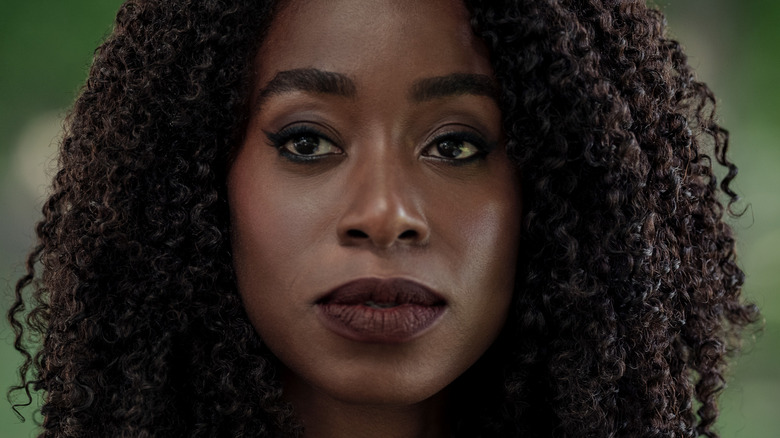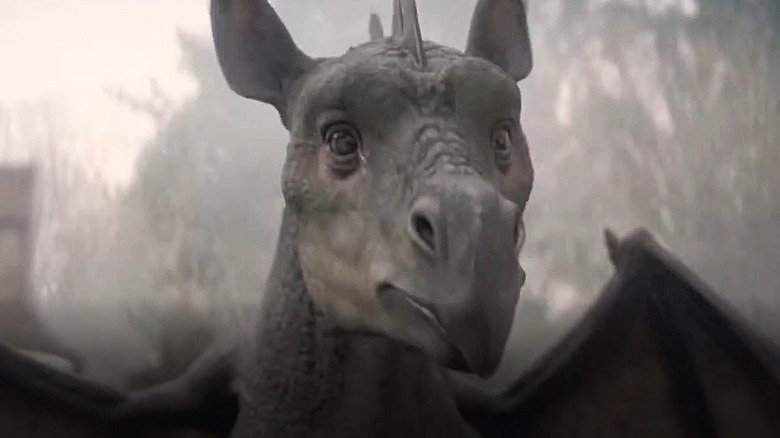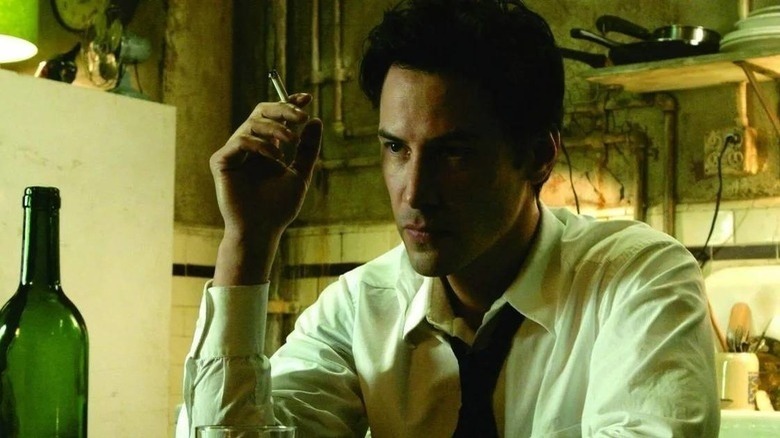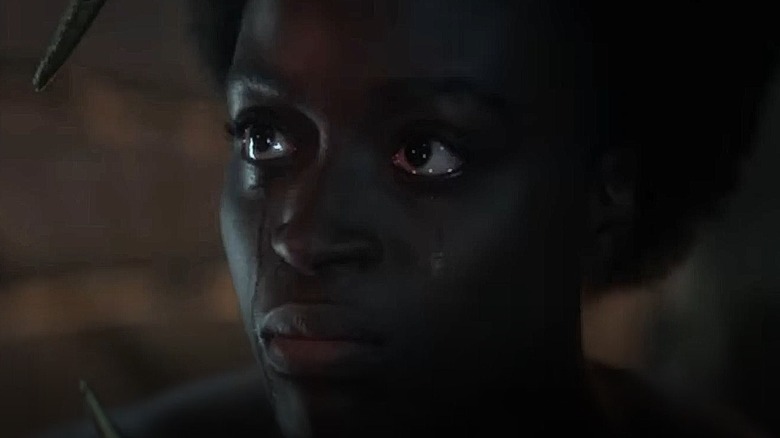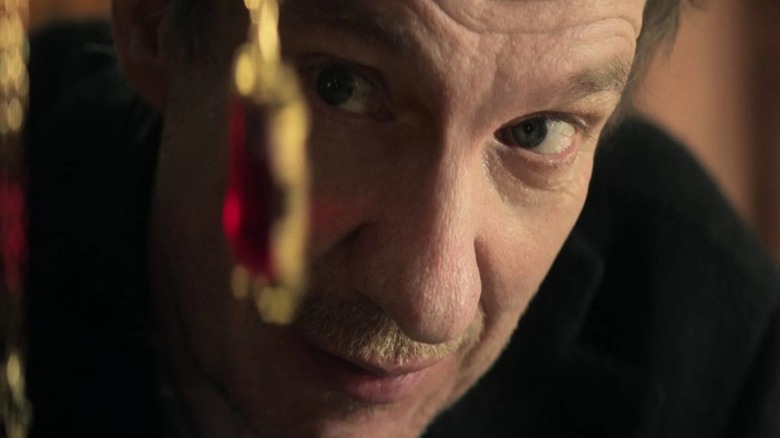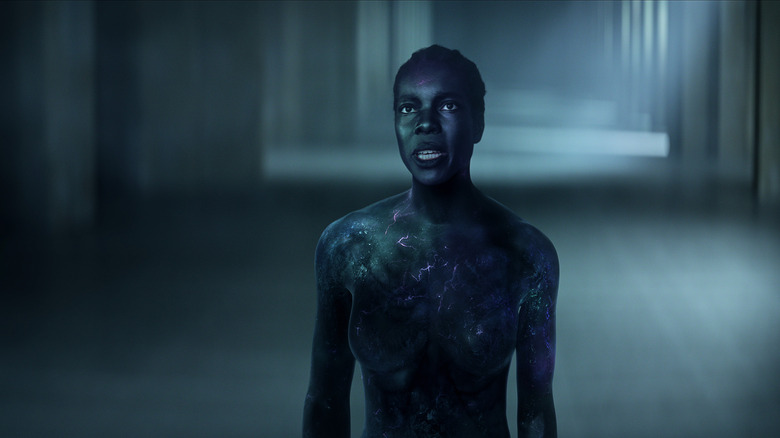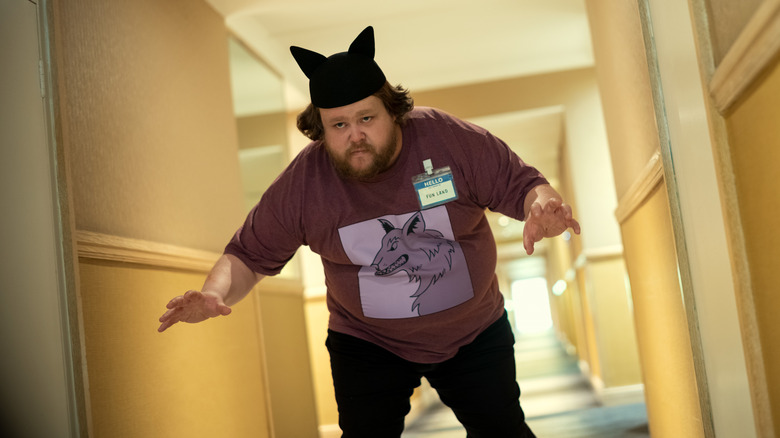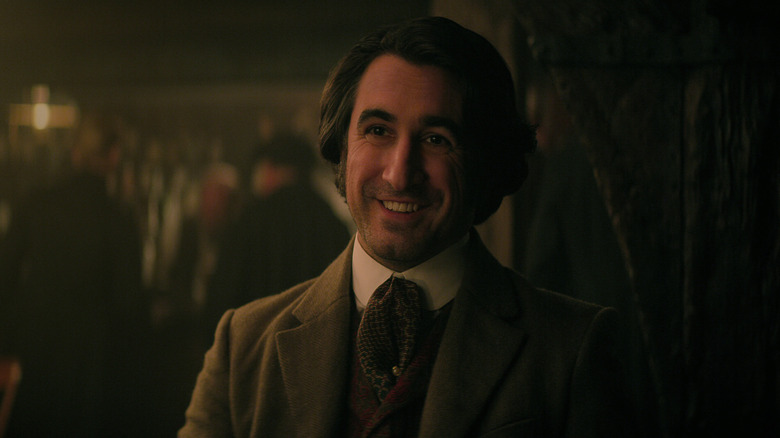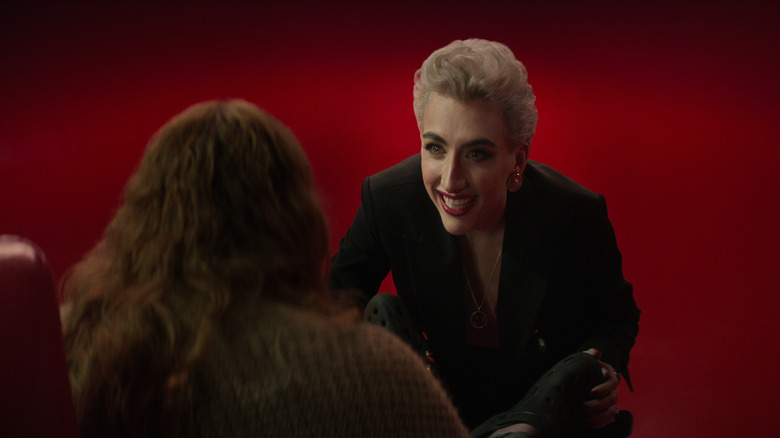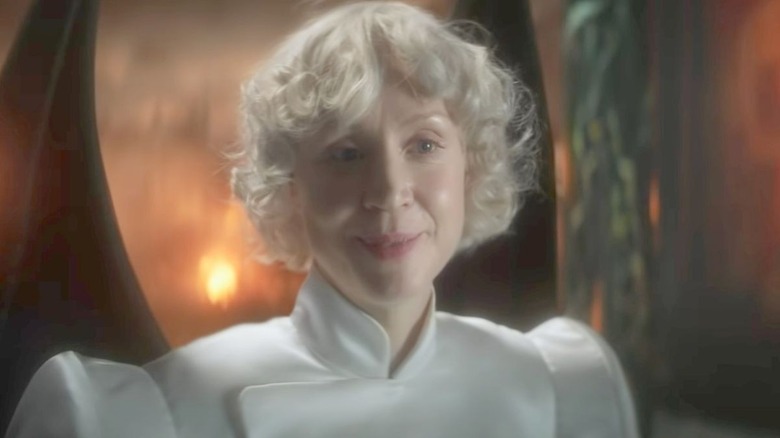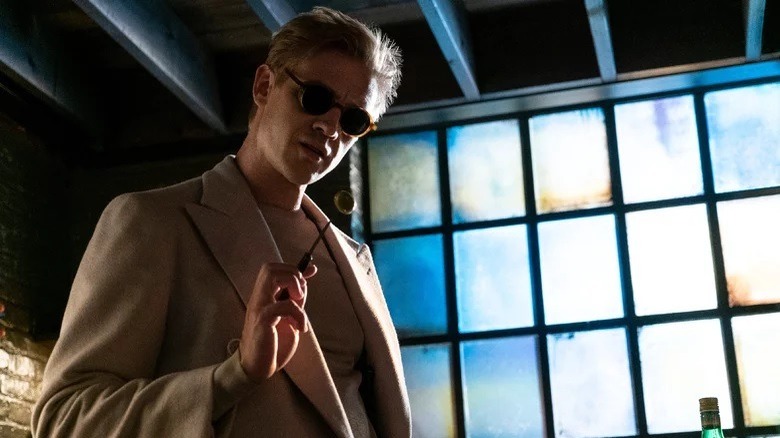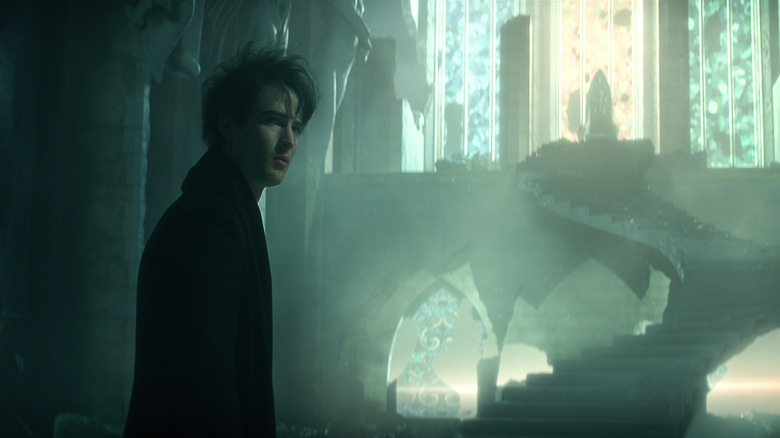Biggest Unanswered Questions From The Sandman Season 1
For all intents and purposes, a property like "Sandman" should be unfilmable. After all, how can someone adapt "a story about stories" and bring a whole new frontier of fantasy to life? Netflix's "The Sandman" has done it, finally delivering a live-action adaptation of Lord Morpheus which has been in the making for decades. Taking inspiration from the DC comic book series, the dark fantasy show explores similar themes and features many of the same fan-favorite characters.
After 10 episodes, "The Sandman" mythology should be a lot clearer to the audience. Fans have now met the Endless, Lucifer Morningstar, and a host of other important characters that form the crux of the narrative. That said, the series doesn't wrap everything up, tie it with a red bow, and hand over all the answers to the viewer. No, it leaves us with a few burning questions to stir up water cooler conversations and pique the interest for potential upcoming seasons of "The Sandman." Keep in mind that these aren't criticisms or complaints about the series; these are merely thought-provoking points that deserve discussion and analysis. Let's dive right in and check out the biggest unanswered questions from "The Sandman" Season 1. Spoilers for "The Sandman" follow.
Will Gregory the Gargoyle come back?
While Neil Gaiman has said that the sixth episode, "The Sound of Her Wings," devastated him (via The Mary Sue), there's an argument to be made that "Imperfect Hosts," the second episode in the Netflix series, might be the one that tore our hearts out and put them in a blender. Morpheus visits Cain and Abel; however, this isn't a social visit to see how things are going between the infamous siblings. The Dream Lord comes back to take the cute-as-a-button Gregory the Gargoyle. Being an absolute sweetheart, Gregory agrees to be a sacrifice for the sake of the Dreaming. If this moment doesn't make a viewer shed enough tears to fill at least a medium-sized wine tumbler, they need to check their humanity for a second.
In the last episode, however, Dream is seen recreating his kingdom and followers. In the background, there's a shape that looks an awful lot like Gregory, which is good news since it could mean the adorable creature is about to be reborn. While Dream did give Cain and Abel a new gargoyle usually known as Goldie, there is always enough room for Gregory as well. In the comics, Gregory and Goldie are friends, so let's hope that everyone respects canon here and ensures Gregory remains a part of this story going forward.
Does John Constantine exist in this Sandman universe?
Before "The Sandman" Season 1 was released, there was a fair amount of debate over swapping out John Constantine for Johanna in the series. Johanna exists in the comic book continuity; however, she takes over John's arc for the show as well. While many fans believe this switch was done purely because of rights issues being tied up with other shows, Neil Gaiman denied this was the case. "I was told there were all sorts of restrictions about using Constantine and that J.J. Abrams had brought these things in, and people were going, 'Ah! You must be doing that because of this,' and I wish I could say, 'Well, yes, we wanted John Constantine,' but no," he told /Film, elaborating how everyone agreed it would make sense to cast Jenna Coleman as Johanna instead.
On the show, Dream reveals how he has known many Constantines over the eons. Of course, this includes Lady Johanna Constantine who also appears during the season, but does this throwaway line suggest the possibility that John could also exist here? If the rumors of a "John Constantine" HBO Max series are true, it's highly unlikely that anyone will see the chain-smoking hellblazer appearing on "The Sandman" anytime soon.
Will Dream go back for his former love?
"The Sandman" Season 1 makes it clear that Dream has gone by many names throughout the ages. During the sixth episode, "A Hope in Hell," Dream and Matthew the Raven go to Lucifer Morningstar's famously cozy and warm realm known as Hell. Along their journey, they encounter a woman named Nada who is imprisoned there. She recognizes Dream, calls him Kai'ckul, and begs him to free her. Dream admits that even though it has been 10,000 years, he still loves her — but he won't free her just yet. When pressed by Matthew about the story of how they know each other, Dream reveals Nada is the leader of a tribe and they fell in love once upon a time, but he sent her to Hell for defying him.
Nada's imprisonment is a shocking example of Dream's ruthless streak, which rears its head on the odd occasion in the series. However, the Lord of Dreams does experience a transformation over the course of the story, as he begins to learn many lessons from humanity, especially about the importance of compassion and forgiveness. After 10,000 years, it might be time for him to let bygones be bygones. He knows where Nada is, and he admits he still loves her, so what are the chances that he'll decide to go back and free her now?
Will John Dee wake up?
When it was announced that David Thewlis would play the role of John Dee in the live-action adaptation of "The Sandman," there was a natural excitement surrounding his casting, especially for those who remember the character from the comic book series. In the "The Sandman: Preludes & Nocturnes," John is an antagonist who hangs onto Dream's ruby, the Dreamstone, and uses it to cause anarchy and chaos. The series tweaks John's origins ever so slightly; however, it keeps most of the main beats from the comics intact, including the shocking and depraved diner scene.
Like in the comics, John shatters the Dreamstone, believing doing so will destroy Dream forever. However, it merely releases the power of the ruby back to the Endless. Rather than strike down John and finish him off once and for all, Dream places him in a deep slumber and tells him to sleep well. John isn't seen again for the rest of the series, so it's unclear if he has been put to sleep for the rest of eternity or if he will wake up later on after a power nap. In the comics, John also goes by the name of Doctor Destiny and clashes with the Justice League on occasion; however, that's unlikely to happen here.
Are Gault's actions to protect Jed right?
The story of Jed Walker is deeply tragic. Alone in the world and isolated from his sister Rose, the young child suffers abuse at the hands of his foster parent, Barnaby. Gault, one of Dream's nightmares, takes it upon herself to interject, and creates her own section of the Dreaming that allows the boy to escape from the nightmare of his reality and to live out a fantasy as a superhero known as The Sandman. Dream slams the nightmare's actions, reminding her of the purpose of nightmares and how they should not interfere in human affairs. Gault rejects Dream's explanation, saying she wants to be a dream and to inspire others rather than terrify them. She recognizes the poor boy's waking reality is horrendous and wants to provide him with some form of escapism.
Dream punishes the nightmare for her actions and for defying him. From his perspective, he wants to ensure that everyone follows their initial purpose and there are fewer rogue nightmares lurking around. However, Gault's actions have far better intentions than the Corinthian's. There's a kindness and innocence in wanting to inspire and help others, which Dream eventually realizes himself. But is it right for nightmares to deviate from their purposes to begin with? That's the philosophical question that needs to be addressed.
What about the collectors who weren't at the Cereal Convention?
In Gotham City, the villains meet in the shadows or in the hidden club nestled under the surface of the Iceberg Lounge. However, in "The Sandman" Season 1, they appear out in public, holding their own conventions that come complete with numerous lessons and lectures about the art of horrendous crimes. The Cereal Convention is a central part of the ninth episode, "The Collectors," where the Corinthian's fellow "collectors" — "collectors" being a thin euphemism for serial killers in this instance — meet to share their wisdom and gloat about being homicidal maniacs under the guise of attending a convention about breakfast cereals. They get their comeuppance in the end, though, as Dream's punishment is for them to feel the intensity and sorrow of all the pain they have caused others. It's essentially a karmic slap that they can't escape from.
While it's a fitting punishment that sorts out all the Corinthian's evil followers in one go, what about all the others who weren't at the convention? Some of them might have had work commitments or even other crimes to attend to that prevented them from partaking in the nefarious celebrations. Ultimately, it means there could be more copycats and evildoers out there who could be showing up in the future to carry on the Corinthian's legacy of horror.
Will Hob ever accept death?
"The Sound of Her Wings," the sixth episode of "The Sandman" Season 1, dives into the deeper meaning of life and death. While the first half of the episode follows Dream and his sister Death as they discuss what the end of life symbolizes to human beings, the second part is about Dream and a human named Hob Gadling, whom the Endless first discover at a tavern in 1389. Hob tells his friends that he refuses death, which is a statement overheard by Dream and his sister. Dream offers him eternal life, with a special caveat — every 100 years, Dream and Hob will meet at the same spot to discuss what's happened since they last met.
Despite the highs and lows of the centuries, Hob shows up every single time. Sometimes, he's more jubilant about events, while at other times he feels deflated by the changes around him. Regardless of what happens and all he sees, Hob still wants to live more. It's an interesting perspective on immortality, as Hob feels there's always much to live for and he's curious to find out how the world will continue to evolve. The question is, will Hob ever grow weary and want Death's sweet embrace? Only time will tell.
Will Desire behave?
Throughout "The Sandman" Season 1, several antagonists appear and show off their true colors. However, the end of the season reveals Desire to have been the mastermind and architect behind the dream vortex that threatened to tear apart Morpheus and the Dreaming. Clearly, Desire holds resentment and anger towards their brother, which isn't about to go away anytime soon. When Morpheus uncovers Desire's involvement in the creation of the dream vortex, he confronts his sibling and emphatically states that there will be consequences if they interfere in his affairs again.
In the comics, the two develop somewhat of a truce after the events of "The Doll's House." However, the glint in Desire's eye on the show and the promise to "draw blood" hints that this ordeal is far from over. Perhaps there will be a momentary respite or even a calm before the storm. That said, don't be surprised if this escalates and the Endless siblings are forced to pick sides in this never-ending battle.
How will Lucifer take revenge on Dream?
While there were many fans who were upset that Tom Ellis didn't reprise his role as Lucifer Morningstar in "The Sandman," Gwendoline Christie embraced the darkness and put on a sinister performance as the ruler of Hell. The big showdown between Lucifer and Dream takes place in the episode "A Hope in Hell" where the two do battle. While it appears as if Dream will fall to Lucifer at one point, he defeats the Lord of Lies in the end.
Lucifer isn't impressed by these events, especially considering Dream embarrasses them in front of all the demons. In the season's final episode, "Lost Hearts," Azazel demands that the kingdom of Hell be expanded, and Lucifer accepts. When asked by Mazikeen what the next step is, Lucifer promises to upset God and bring down Morpheus. In the comics, Lucifer gets rid of their wings and retires — but at the moment, it doesn't appear as though the same will happen here. The Devil has a plan ... but it isn't clear what it is just yet.
Will Dream come back for Lyta's child?
When we meet Lyta Hall in "The Sandman" Season 1, it's clear that she still hasn't dealt with the loss of her husband, Hector. She prefers to spend her time asleep, where she is able to speak and spend time with her husband, who is alive in her dreams. Hector asks her to stay with him, and she becomes pregnant in the Dreaming. To her surprise, it turns out she is also carrying the child in the Waking World. Later in the story, Dream explains that since the child was created in the Dreaming, it belongs to him. He also vows to come for the child in the future.
At the end of "The Sandman" Season 1, Lyta gives birth and Dream appears to soften his stance towards, well, everything in general. However, it is never revealed if he will or won't come back for Lyta's baby. It is possible that he may stay true to his word and return for the child later on. As an interesting side note, Lyta is the daughter of Wonder Woman and Steve Trevor in "Sandman" comics.
Can Dream make a flawless Corinthian?
The Corinthian is introduced as a renegade nightmare on the show. He has no intention of ever going back to the Dreaming since he loves being a narcissistic sadist and enjoying all the forbidden fruits of the Waking World. For most of "The Sandman" Season 1, he tries to outrun Dream while leaving a trail of carnage and devastation in his wake. Eventually, he comes face to face with his maker, who destroys him while promising to make an improved Corinthian sometime in the future.
Back in the Dreaming, Lord Morpheus remakes his creations, but he hands the skull of the Corinthian to Lucienne and asks her to keep it safe for him. Undoubtedly, this indicates that he has plans for this nightmare somewhere down the line — just not right now. Even so, is it possible that he'll be able to successfully create a version of the Corinthian who won't break bad again? He could end up being more loyal to Dream; however, his homicidal tendencies might be a little tougher to curb, as we've seen in the comics.
Which other famous figures did Dream inspire?
During one of Dream's meetings with Hob Gadling, he hears all about William Shakespeare. However, it's clear that the people of the era don't appreciate the playwright's talents and view him more as an oddball than anything else. Dream, though, is fascinated by what he overhears as Shakespeare speaks to someone else. The Lord of Dreams approaches Shakespeare and offers to talk to him further.
There's no second guessing the meaning here — Dream inspires Shakespeare and opens his mind to endless potential, perhaps serving as a muse of sorts. Even Hob is left with no doubt that Dream had a hand in shaping Shakespeare's legacy and work. It begs the question — If Lord Morpheus helped Shakespeare, which other famous historical figures did he approach throughout the ages? He could have inspired musicians, filmmakers, photographers, sculptors — the list is endless ... pun intended.
